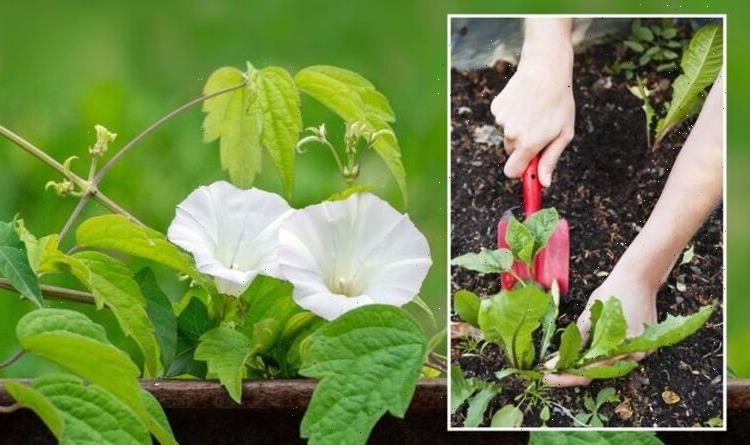Gardening expert demonstrates how to get rid of weeds
We use your sign-up to provide content in ways you’ve consented to and to improve our understanding of you. This may include adverts from us and 3rd parties based on our understanding. You can unsubscribe at any time. More info
If garden weeds are ignored, they can spread and set seed. This will cause bigger problems later down the line and they may be harder to eradicate. With many gardeners starting to find weeds outside, Gardeners’ World have shared top tips on how to eradicate them now.
Weeds are wild plants that grow in the wrong place.
They can have benefits for wildlife in the garden, but they can also grow rapidly, looking unsightly in the garden.
There are many types of common weeds in the UK, including bindweed, couch grass and dandelions.
Luckily, the majority of common weeds can be removed in the same way.

Gardeners’ World explained: “There are lots of different ways to deal with weeds, from hoeing to putting them up.
“It’s best to weed on a dry day, when the soil is moist – this will make them easier to dig up, then clear away.”
One way to help remove weeds in the garden is to simply dig them up.
Using a garden hand trowel is the best way to stop spreading weeds like couch grass.
DON’T MISS:
Flowers to ‘plant now’ for ‘vibrant’ summer blooms [COMMENT]
Give plants a ‘boost’ using ‘homemade’ plant food – including coffee [EXPERT]
‘Must have’ house feature which could add £13k to the house value [EXPLAINER]
Gardeners’ World added: “If digging up perennials such as bindweed or nettles, dig deep using a garden fork and be sure to pull up the whole root, as tiny pieces left will become new weeds.”
Gardeners can also hoe over bare areas of soil weekly to prevent weeds from growing.
Hoeing can help to create a dry surface that prevents weed seeds from germinating and growing.
It is recommended to hoe the soil on a dry day, so that weeds on the surface dehydrate, wither and die.

Another simple method is to simply pull them out.
Gardeners’ World explained: “Pull out annual weeds such as groundsel with the roots, before they have a chance to set seed.
“Hand weed after rain has softened the soil, allowing you to pull out complete root systems.
“Scrape out weeds, such as dandelions or meadow grass, between gaps in paving using a weeding tool or an old knife.

“Tease them out, roots and all. You could also apply a residual path weedkiller afterwards, to prevent further weed growth.”
For those who have a bad infestation, chemicals may be used to help remove them.
A systematic weedkiller can be sprayed or dabbed onto dry leaves when rain is not forecast.
If tackling bindweed, Gardeners’ World recommended training it up a bamboo cane first to isolate it from other plants.
Japanese knotweed, which is one of the most invasive weeds in the UK, can be a serious problem and can be difficult to eradicate.
Growing during the spring months, Britons should watch for signs of it growing in their garden as it can devalue property prices.
The destructive weed has distinctive zig-zag patterns along the stems and visible nodes between stems sections.
Professional help may be required to help remove Japanese knotweed.
Source: Read Full Article
